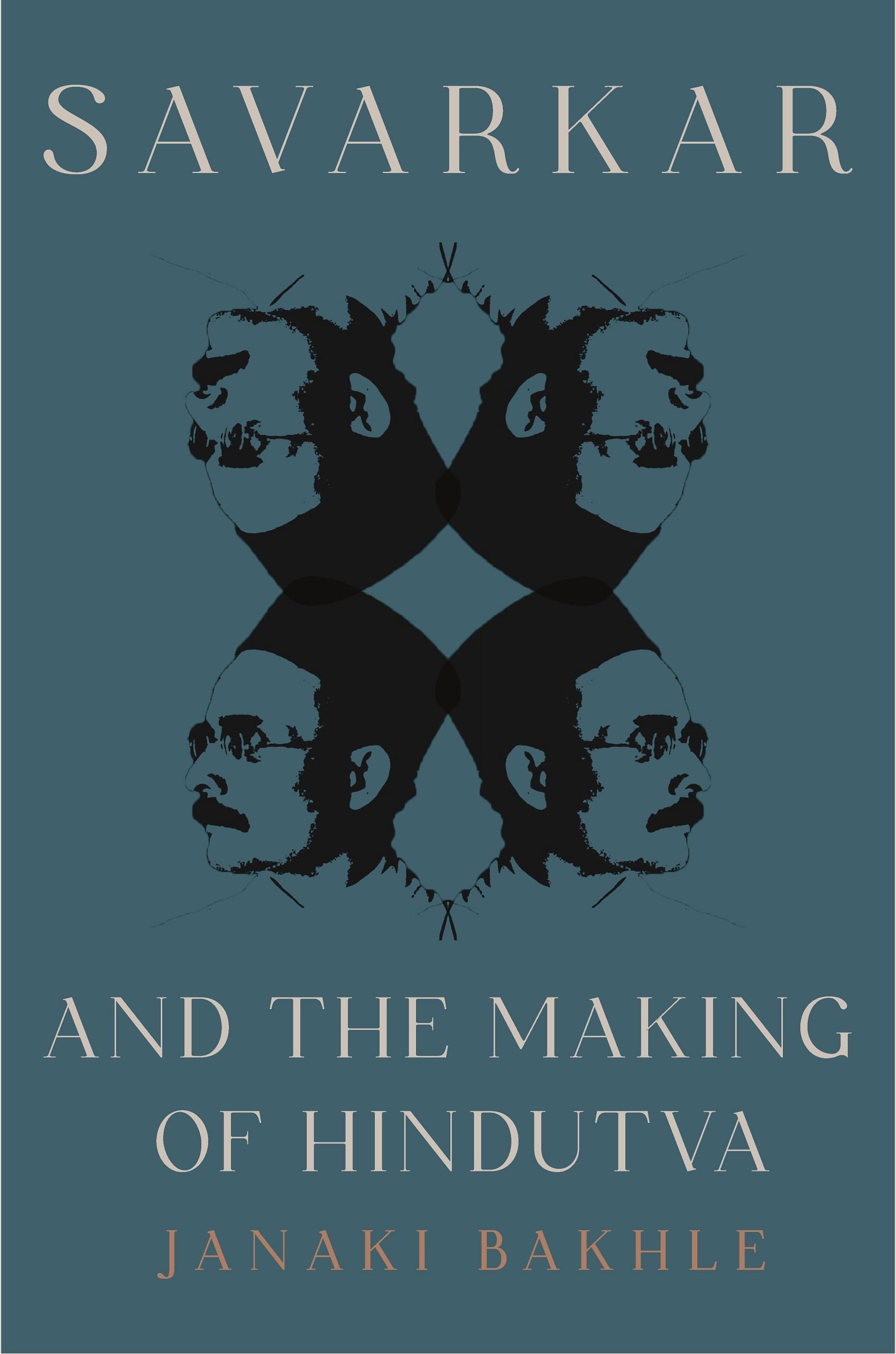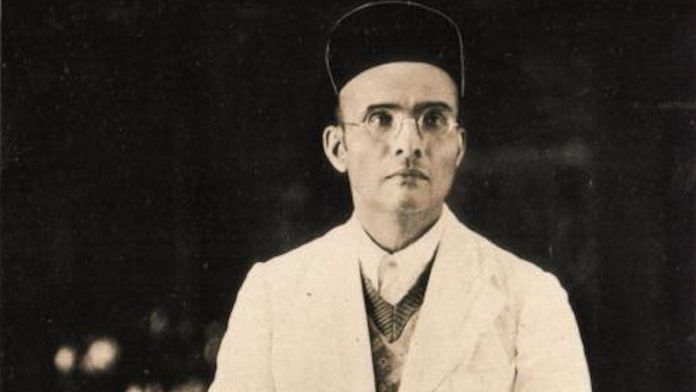Savarkar may have recognized that every issue of caste was also an issue of gender (even if the reverse was not necessarily true), and he knew that he needed women to be full members of the Hindu fold. He was tolerant of caste intermarriage, as long as Hindu women did not marry non-Hindus, as he made clear in a letter he wrote (in English) to his younger brother in 1913:
And how do you like Bengal? By this time after the Puja holidays you are back to Calcutta and must have grown quite into a Bengali Babu-is it not? Forgotten Marathi language? Please take care you do not lose something else. For I am afraid I might hear at any time that some one of those clever Bengalis has stolen your heart away! Though I for one should like so much to have found a dear little Bengali sister in-law. I am as strongly in favour of these inter-provincial marriages among the Hindus as I am deadly opposed to the practice of marrying the European girls at this stage of our national life.
This advocacy of interregional marriages was exceptional for its time when it would have been quite scandalous for a Bengali Brahmin to have married a Marathi Brahmin. But on the question of anulōma/pratilōma marriages, or intercaste marriages between Sudras and Brahmins, Savarkar did not engage in the kind of advocacy for such marriages as the one real route to the annihilation of caste as did Ambedkar but focused instead on demonstrating through a reading of epic literature that there are no genetic or blood-linked differences between the castes. The miscegenation that Ambedkar was recommending was, for Savarkar, already in place and had been so for centuries. Thus, while he wrote enthusiastically about interregional marriage, he did not explicitly advocate that Brahmins marry Mahars or make a case for intercaste marriages and indeed suggested that any such imposed agenda would not work, neither for upper castes nor untouchables. This was all implicit in his assumption that caste should disappear in favor of everyone being Hindu and that one should be free to choose one’s life partner. His most polemical attack against the prohibition against intermarriage comes when he shows that, to maintain absolute caste purity, the sons and daughters of kings would have no alternative but to marry each other. Savarkar points to the story of Lot in the Bible and an unnamed Buddhist rendition of the Rāmāyaṇa that was published in Kesari:
The Buddha’s clan too believed that relations between siblings led to increased genetic prosperity, and maybe to ensure the Buddha’s own heirs are genetically strong, the Buddhist Ramayana describes Ram and Sita as brother and sister who fall in love and then get married.
Because of this, the idea of maintaining caste purity was itself absurd.
In July 1916, congratulating his brother—the one he’d suggested might want a sweet Bengali wife—he had this to say:
For though I long to see the day, when inter-provincial marriages amongst the Hindus would throw down the artificial and harmful barriers of castes and creeds and the Great River of life—our Hindu Life would, having freed itself of all bogs and sands, flow in an ever fresh and mighty current- uninterrupted and uninterruptible—still the first and foremost thing to be affected. In that direction is to restore to love her sole privilege and right of presiding over the wedding rights. Indeed, we can no longer be blind to the fact that we care more for the good breeding of cattle and fowls than for the Eugenics of man. Centuries of child marriages and marriages by proxies!
Centuries of love banished from its legitimate sphere of influence to attract and develop elements that tend to the betterment of body and mind and soul; and the inevitable result is a race puny, debilitated, all vigour and manhood sapped out of it. Thousand things have wrought this—and the marriage customs that prevail in us are one of the few important factors contributing to it. Authorities should come in to sanctify but not to silence love altogether [emphasis mine].
Savarkar’s use of the term “Eugenics of man” and a “race puny” startles us today, given how much eugenics is linked to Nazi terror and the brutal weaponization of science against minorities and otherwise oppressed groups. We can be quite sure that Savarkar had read the works of evolutionists and eugenicists such as Charles Darwin (1809–82), Francis Galton (1822–1911), and Herbert Spencer (1820–1903). Spencer, an English sociologist and philosopher, had suggested that society should simply evolve according to natural law, which would weed out the weakest elements of society. Darwin too, in his Descent of Man (1871), had applied his earlier evolutionary thinking to human beings, warning that if the lower classes continued to outbreed their social superiors, evolution would regress. Darwin’s cousin, Francis Galton, another English explorer and anthropologist who coined the term “eugenics,” had suggested in 1865 that humans should take control over their evolution, pitching the idea that a positive eugenics could encourage the right sorts of people to reproduce. Spencer’s philosophy was not without contradiction, given that he was a stringent critic of imperialism, seeing it as a sociological pathology that infected both colonizer and colonized; he was no fan of state intervention in social progress. Yet Spencer’s sociological organicism in the colonial context, as Inder Marwah puts it, “enabled a notable shift by situating the motive force of social and political evolution not in external steering, but internal transformation. Progress turned on Indians’ own capacities to reform social, political, and economic practices—to heal the social body—as a conjunct organism, from within.” In other words, Spencer’s sociological organicism, with all its ambivalences and contradictions, allowed nationalists to move the focus from “benevolent empire to the Indian social body, pinning India’s advancement on the social organism’s endogenous evolution.” Such endogenous evolution was exactly what Savarkar was advocating.
Since the banishing of love from the social sphere had produced a puny race, the remedy was to return love to its rightful place. And indeed, love played a big role in Essentials of Hindutva. Love for the nation was, for Savarkar, proof of patriotism that could guarantee citizenship. Here, love, albeit with major qualifications (between Bengal and Maharashtra but not Hindus and Muslims as Gandhi later advocated or overtly intercaste as Ambedkar did), could eradicate caste. It was not going to be easy, he conceded many years after writing these letters to his brother. In one funny example, he noted that if a Marathi Brahmin girl was married into a Bengali family, it would produce all manner of problems. Take, for instance, dining habits.
When mother-in-law and daughter-in-law get to cooking a meal, the [Bengali] mother-in-law was likely to instruct her [Marathi] daughter-in-law to “clean these four fish for me, please.” When they sit for dinner, according to the customs of Bengali Brahmins, the mother-in-law is going to scarf, scarf, scarf down that fish stew, the Marathi Brahmin daughter in law is going to barf, barf, barf at the very smell of that fish stew.
Such unions could not be forced or imposed, but if they happened naturally, they should be encouraged and destigmatized.
 Excerpted from SAVARKAR AND THE MAKING OF HINDUTVA by Janaki Bakhle. Copyright © 2024 by Janaki Bakhle. Reprinted by permission of Princeton University Press.
Excerpted from SAVARKAR AND THE MAKING OF HINDUTVA by Janaki Bakhle. Copyright © 2024 by Janaki Bakhle. Reprinted by permission of Princeton University Press.



